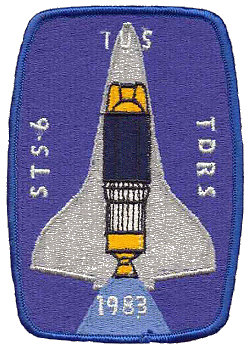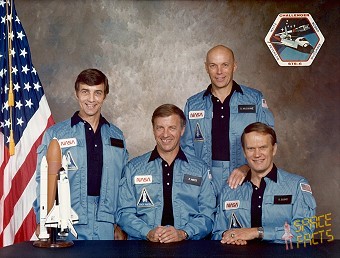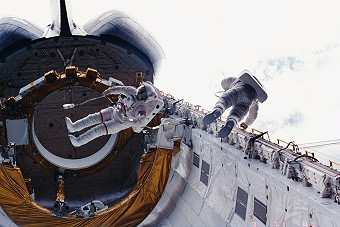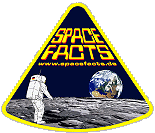Human Orbital Spaceflights
![]()
International Flight No. 86STS-6Challenger (1)6th Space Shuttle missionUSA |
 |
 |
 |
 |
|
 |
||
![]()
Launch, orbit and landing data
walkout photo |
 |
||||||||||||||||||||||||||||
alternative crew photo |
|||||||||||||||||||||||||||||
alternative crew photo |
Crew
| No. | Surname | Given names | Position | Flight No. | Duration | Orbits | |
| 1 | Weitz | Paul Joseph | CDR | 2 | 5d 00h 23m 42m | 81 | |
| 2 | Bobko | Karol Joseph "Bo" | PLT | 1 | 5d 00h 23m 42m | 81 | |
| 3 | Musgrave | Franklin Story | MS-1, EV-1 | 1 | 5d 00h 23m 42m | 81 | |
| 4 | Peterson | Donald Herod | MS-2, EV-2, FE | 1 | 5d 00h 23m 42m | 81 |
Crew seating arrangement
|
 |
|
||||||||||||||||||||
Hardware
| Orbiter : | OV-099 (1.) |
| SSME (1 / 2 / 3): | 2017 (1.) / 2015 (1.) / 2012 (1.) |
| SRB: | A17/18 |
| ET: | ET-8 (LWT-1) |
| OMS Pod: | Left Pod 01 (1.) / Right Pod 01 (1.) |
| FWD RCS Pod: | FRC 9 (1.) |
| RMS: | - |
| EMU: | EMU No. 1026 (PLSS No. 1003) / EMU No. 1024 (PLSS No. 1005) EMU No. 1025 (PLSS No. 1006) |
Flight
|
Launch from Cape Canaveral (KSC) and
landing on Edwards AFB, Runway 22. Maiden voyage of orbiter Challenger.
Beginning with the external tank built for use on STS-6, all future tanks will be more than 4,536 kg (10,000 lb.) lighter than the tank which flew on the Space Shuttle's maiden flight in April 1981. Although, the weight of each future tank may vary slightly, each will weigh about 30,390 kg (67,000 lb.). The external tank is actually made up of two tanks and a collar-like intertank which connects the two. The two individual tanks carry the liquid hydrogen and liquid oxygen for the Space Shuttle's three main engines. Total length and diameter of the tank remains unchanged due to the weight reduction. Originally the launch was planned for January 30, 1983 but a hydrogen leak in one of the main engines forced to delay the launch. An additional delay was caused by contamination to the Tracking and Data Relay Satellite-1 (TDRS-1 / TDRS-A respectively) during a severe storm. The crew deployed the communications satellite TDRS-A, but it reached only an elliptical orbit. Using it's own thrusters, it was able to reach the planned orbit after a few months. TDRS-A is the first of three identical spacecraft which are planned for the TDRS system. The TDRS system was developed following studies in the early 1970s which showed that a system of telecommunication satellites operated from a single ground station could better support the Space Shuttle and planned scientific and application mission requirements and, at the same time also halt the spiraling cost escalation of upgrading and operating a worldwide tracking and communications network of ground stations. The TDRS are the largest privately owned telecommunications spacecraft ever built, each weighing about 2,268 kg (5,000 lb.). Each satellite spans more than 17.4 m (57 ft.) measuring across the solar panels. The singleaccess antennas, fabricated of woven molybdenum mesh and plated with 14K gold, each measure 4.9 m (16 ft.) in diameter, and when deployed, span more than 12.8 m (42 ft.) from tip to tip. The TDRS are composed of three distinct modules: an equipment model, a communications payload module, and an antenna module. The modular structure reduces the cost of individual design and construction efforts that, in turn, lowers the cost of each satellite. The equipment module housing the subsystems that operate the satellite and the communications service is located in the lower hexagon of the spacecraft. The attitude control subsystem stabilizes the satellite so that the antennas have the proper orientation toward the earth and the solar panels toward the sun. The electrical power subsystem consists of two solar panels that provide a 10-year life span of approximately 1,700 watts power. The thermal control subsystem consists of surface coatings and controlled electric heaters. The communications payload module is composed of the electronic equipment and associated antennas required for linking the user spacecraft with the ground terminal. The receivers and transmitters are mounted in compartments on the back of the single-access antennas to reduce complexity and possible circuit losses. The antenna module is composed of four antennas. For single-access services, each TDRS has two dual-feed S-band/Ku-band deployable parabolic antennas. These antennas are 4.9 m (16 ft.) attached on two axes that can move horizontally or vertically to focus the beam on orbiting spacecraft below. Those antennas are used primarily to relay communications to and from user spacecraft. The high bit-rate service made possible by these antennas is available to users on a time-shared basis. Each antenna simultaneously supports two user spacecraft services (one at S-band and one at Ku-band). For multiple-access service, the multi-element S-band phased array of helical radiators is mounted on the satellite body. The multiple-access forward link (between TDRS and the user spacecraft) transmits command data to the user spacecraft. In the return link, the signal outputs from the array elements are sent separately to the White Sands Ground Terminal parallel processors. The first EVA of the Shuttle program was performed by Story Musgrave and Donald Peterson on April 07, 1983 (4h 10m). The first Shuttle EVA (and first U.S. EVA since February 1974) was planned to occur during STS-5, but was scrubbed because of Shuttle EMU malfunctions. Story Musgrave checked out the three suits - two primary and one backup - carried in Challenger's airlock early in the flight to provide additional time for troubleshooting should one of the 125 kg (275 lb) suits prove faulty. The Shuttle EMU is first operational U.S. space suit built specifically for EVA. Nominal suit operating pressure is 29.7 kilopascal (4.3 psi). The EMU consists of the Primary Life Support System (PLSS) and the Space Suit Assembly (SSA). The SSA is built around the fiberglass Hard Upper Torso (HUT). Water, oxygen, electricity, and data pass between the PLSS and the HUT through an interface pad behind the astronaut's left shoulder. Most SSA components can fit men and women from the 5th to 95th percentiles of body size. There are four HUT sizes, six waist bearing sizes, and two boot sizes (the latter with six sizes of sizing insert "slippers"). There are also nine standard glove sizes, but generally astronauts opt for customized gloves when possible. This is the only customizable part of the Shuttle EMU, pointing up the importance placed on adequate gloves in EVA work. The Display and Control Module (DCM) is mounted on the front of the HUT. A microprocessor in the DCM monitors suit condition - the EMU is the first computerized space suit. The astronauts reported after the flight that, despite attempts by engineers to make the Shuttle EMU self-donning, an IV crewman was required to close the EMU waist ring. The exercise treadmill and extra EMU interfered with suit donning. Story Musgrave and Donald Peterson "stood" face to face in the airlock, which lead to thrashing and noise. Despite this, they managed to doze during the 3-hour in-airlock prebreathe. The astronauts left the airlock over Borneo and assessed EMU mobility by translating aft along the handholds inside the payload bay door hinge. Paul Weitz and Karol Bobko observed from the aft flight deck. Story Musgrave climbed to the top of the payload bay aft bulkhead and looked back over Challenger's engine bells. He referred to his Weightless Environmental Training Facility (WETF) neutral buoyancy EVA training when he quipped that "this is a little deeper pool than I'm used to working in." Shuttle Program Manager Glynn Lunney said that "EVA on Shuttle is wide-ranging even when you stay in the cargo bay." Story Musgrave and Donald Peterson demonstrated contingency payload bay door closure without actually closing Challenger's 18.3-m-long (60-ft-long) doors. They had difficulties rewinding the payload bay door EVA winch and considered cutting the winch cable, but Mission Control vetoed this and the cable came free. They also went through the motions of lowering a jammed satellite tilt table. Story Musgrave reported that his fingers were cold. The Continuous Flow Electrophoresis System, the first commercial experiment flown aboard the Space Shuttle, made a return visit to space on STS-6. In addition to experimentation by the company, this flight marks the first use of the device by NASA scientists to expand the knowledge base of electrophoretic separation processes and further characterize the effects of gravity on continuous flow electrophoresis. The electrophoresis system, developed by the McDonnell Douglas Astronautics Co., St. Louis, Mo., and initially carried into space on STS-4, has the potential for separating biological materials for both research and the production of pharmaceuticals. The device is designed to separate biological materials according to their surface electrical charge as they pass through an electric field. Unlike previous electrophoresis experiments conducted in space on the Apollo-Soyuz Test Project and on STS-2, this device processes large quantities of materials carried in a continuous stream. The Monodisperse Latex Reactor (MLR), is a materials processing in space experiment carried and operated in the middeck area of the orbiter cabin. The purpose of this experiment is to study the kinetics involved with the production of uniformly sized (monodisperse) latex beads (tiny spheres) in a low-gravity environment where the effects of buoyancy and sedimentation are minimized. The experiment consists of four, 3-m (l-ft.)-tall reactors, each containing a chemical latex-forming recipe, housed in a .6-m (2-ft.)-tall metal cylinder. The recipe consists of a suspension of very small latex beads in water plus other chemical ingredients which cause the beads to polymerize when the experiment is activated on orbit. An experiment which studies lightning and thunderstorms from orbit was being flown again on STS-6. The experiment, entitled the Nighttime/Daylight optical Survey of Thunderstorm Lightning, has been conducted on two previous Shuttle flights, STS-2 and STS-4. The techniques developed to identify lightning discharges in this experiment help in the development of sensors to identify severe weather situations from future meteorological satellites. Lightning discharges are detected by the photo-optical system (photocell), which creates an electronic pulse in response to the detection of a lightning flash. These pulses will be recorded on the other recorder channel. A lightning event, which is visible as only one flash, is usually composed of many separate discharges, or strokes, which are distinguished by the photocell. Other STS-6 cargo included three GAS canisters. The experiments were: Artificial Snow Crystal Experiment - a $10,000, 5 cubic-foot (0.14 cubic meter) experiment, sponsored by the Asahi Shimbun newspaper in Tokyo; Seed Experiment - a $3,000, 2 ½ cubic-foot (0.07 cubic meter) experiment by the George W. Park Seed Co. of Greenwood, S.C.; SCENIC FAST - (FAST meaning FAlcon Shuttle Test) a $10,000, 5 cubic-foot (0.14 cubic meter) experiment designed by U.S. Air Force Academy cadets at Colorado Springs. |
EVA data
| Name | Start | End | Duration | Mission | Airlock | Suit | |
| EVA | Musgrave, Story | 07.04.1983, 21:0? UTC | 08.04.1983, 01:2? UTC | 4h 10m | STS-6 | Challenger | EMU No. 1026 |
| EVA | Peterson, Donald | 07.04.1983, 21:0? UTC | 08.04.1983, 01:2? UTC | 4h 10m | STS-6 | Challenger | EMU No. 1024 |
Photos / Graphics
 |
 |
 |
 |
 |
 |
 |
 |
 |
 |
 |
 |
 |
 |
 |
 |
 |
 |
 |
 |
 |
|
more EVA photos |
|
| © |  |
Last update on October 21, 2025.  |
 |